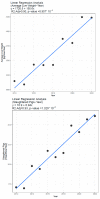The Impact of PRRS Eradication Program on the Production Parameters of the Hungarian Swine Sector
- PMID: 37174602
- PMCID: PMC10177063
- DOI: 10.3390/ani13091565
The Impact of PRRS Eradication Program on the Production Parameters of the Hungarian Swine Sector
Abstract
Background: The Hungarian national eradication program of PRRS was successfully completed between 2014 and 2022. There were doubts about the efficiency of the eradication program in Hungary from the beginning to the tune that it might only be carried out efficiently through depopulation-repopulation of the infected herds, which is a very costly procedure. In our study, we investigated the impact of the depopulation-repopulation procedure, which played a prominent role in the PRRS eradication program on the productivity of the Hungarian swine sector-namely, on the number of slaughter pigs per sow per year and the total live slaughter weight per sow per year.
Material and methods: Since 2014, we monitored the evolution of the PRRS eradication through the depopulation-repopulation approach on the large-scale breeding herds in Hungary. Most producers replaced their herds with animals that were free of PRRS and other infectious diseases (mycoplasmosis, actinobacillosis, swine dysentery, atrophic rhinitis, etc.). On this basis, we evaluated the change in the number of slaughter pigs per sow per year as a consequence of depopulation-repopulation of the herds being carried out. In the statistical analysis linear regression was used.
Conclusions: The results of our study demonstrate that the PRRS eradication program with the herd depopulation-repopulation approach led to a considerable improvement of the productivity of Hungarian pig farming. This result also demonstrates that, independent of the PRRS eradication, it is still necessary to consider investments into the individual production units to increase efficiency, and to carry out herd depopulation-repopulation in cases where the current genetics limits improvements in productivity.
Keywords: PRRS; eradication program; production parameters.
Conflict of interest statement
The authors declare no conflict of interest.
Figures
References
-
- Central Statistical Office The Role of Agriculture in the National Economy. 2018. [(accessed on 18 March 2022)]. Available online: https://www.ksh.hu/docs/hun/xftp/idoszaki/mezo/mezoszerepe18.pdf. (In Hungarian)
-
- Szabó I., Molnár T. Az Aujeszky-betegségtől való mentesítés Magyarországon 1998–2002 között (Eradication of Aujeszky-disease in Hungary between 1998 and 2002) Magy. Áo. Lapja. 2004;126:80–86. (In Hungarian)
-
- Pork Checkoff Study Cost of PRRS Reaches $664 Million Annually. [(accessed on 12 April 2022)]. Available online: https://www.nationalhogfarmer.com/health-diseases/cost-prrs-reaches-mill....
-
- Holtkamp D.J., Polson D.D., Torremorell M., Morrison B., Classen D.M., Becton L., Henry S., Rodibaugh M.T., Rowland R.R., Snelson H., et al. Terminology for classifying swine herds by porcine reproductive and respiratory syndrome virus status. J. Swine Health Prod. 2011;19:44–56. - PubMed
LinkOut - more resources
Full Text Sources



